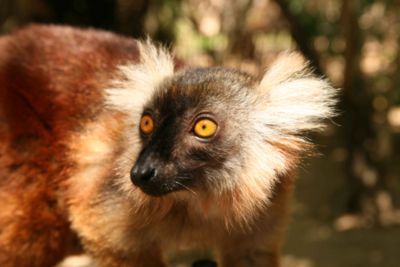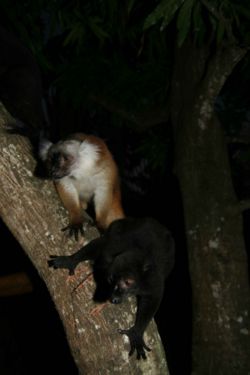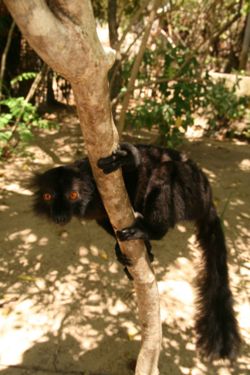Eulemur macaco (Black Lemur): Difference between revisions
imported>Lee R. Berger No edit summary |
imported>Chris Day (no need for cats) |
||
| Line 30: | Line 30: | ||
==References== | ==References== | ||
{{reflist}} | {{reflist}} | ||
Revision as of 13:12, 7 September 2007

The black lemur Eulemur macaco macaco, a so called "true lemur", is a medium-sized quadrupedal Lemur. In the wild, it is found only on the island of Madagascar.
Description
The black lemur is a cathemeral Primate that has a head body length of approximately 39 – 45 cm and a tail length of around 50-65 cm[1][2][3]. Weight ranges between approximately 3 and 3.5 kg[3]. Males are typically dark chocolate brown to black, while females have golden-brown to chesnut colored backs and light colored bellies. The female's face is grey to black, the crown a darker grey and the ears white tuffed [3]. The eyes of both sexes are orange [3].

Behaviour
The black lemur is highly adaptable to different habitats and group sizes range from 2 to 15 [3]. Females give birth to typically a single young usually between September and November[3].

Diet
It is highly frugiverous but also eats seeds, leaves and nectar [2][3].
Geographical distribution
The black lemur may be found in tropical moist lowland and montane forested areas of northwestern Madagascar and on islands around Nosy Be[3].
Status
The black lemur is considered to be endangered by the IUCN.
External links
References
- ↑ J. Fleagle (1998). Primate Adaptation and Evolution. Academic Press: New York.
- ↑ Jump up to: 2.0 2.1 F. Szalay and E. Delson (2001). Evolutionary History of the Primates. Academic Press, New York.
- ↑ Jump up to: 3.0 3.1 3.2 3.3 3.4 3.5 3.6 3.7 Mittermeier et al. (2006). Lemurs of Madagascar. Conservation International.